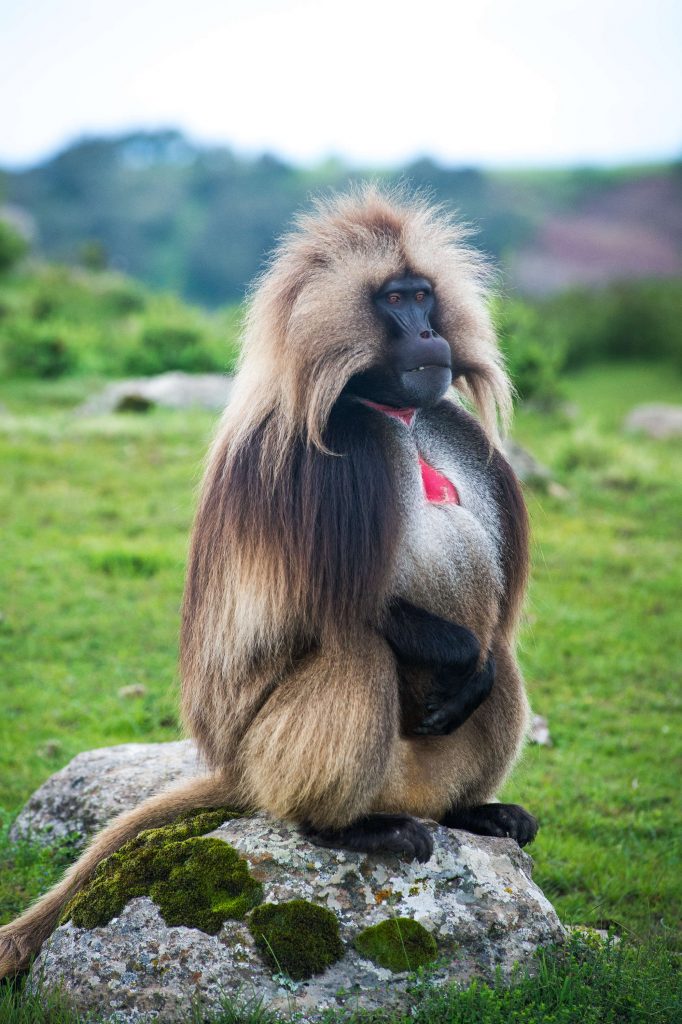Ethiopians know it as the Roof Of Africa. To biologists, it is the most important biodiversity hotspot in northern Ethiopia, populated by an alluring wealth of endemic plants and animals. The Simien Mountains National Park is also Ethiopia’s premier trekking and walking destination.
 Ethiopia’s premier trekking and walking destination, the 412km2 Simien Mountains National Park was inscribed as a Natural World Heritage Site in 1979, whereupon UNESCO lauded it as “one of the world’s most spectacular landscapes, with jagged mountain peaks deep valleys and sharp precipices dropping some 1,500m”. In addition to the splendid scenery and hiking opportunities, the Afromontane meadows and moorlands of the upper Simiens also form one of Ethiopia’s most important biodiversity hotspots, populated by an alluring wealth of endemic plants and animals including Walia ibex, gelada baboon and Ethiopian wolf.
Ethiopia’s premier trekking and walking destination, the 412km2 Simien Mountains National Park was inscribed as a Natural World Heritage Site in 1979, whereupon UNESCO lauded it as “one of the world’s most spectacular landscapes, with jagged mountain peaks deep valleys and sharp precipices dropping some 1,500m”. In addition to the splendid scenery and hiking opportunities, the Afromontane meadows and moorlands of the upper Simiens also form one of Ethiopia’s most important biodiversity hotspots, populated by an alluring wealth of endemic plants and animals including Walia ibex, gelada baboon and Ethiopian wolf.
- The bedrock of the Simien Mountains comprises a vast and ancient basaltic dome moulded into a series of jagged pinnacles and buttresses by glacial activity and precipitation. More than a dozen of its peaks top the 4,000m mark, including the 4,533m Ras Dejen, which is Ethiopia’s tallest mountain.
- The Afromontane vegetation of the Simien Mountains includes more than 1,200 plant species, of which three are endemic to the national park. Above 3,700m, the dominant vegetation type is open grassland punctuated by spectacular giant lobelias that stand up to 10m high. Giant heather trees and other ericaceous plants are the main vegetation type between the 3,000m and 3,700m contour.
- Simien protects an alluring selection of endemic wildlife. It is the last remaining stronghold of the impressively horned Walia ibex, the only goat indigenous to sub-Saharan Africa. Large troops of gelada baboon are rendered unmistakable by the male’s flowing lion-like mane and heart-shaped red chest patch. A population of around 50 Ethiopian wolves is the world’s second largest after Bale Mountains National Park. Other large mammals include Anubis baboon, Hamadryas baboon, grivet monkey, Menelik’s bushbuck, klipspringer, common jackal, spotted hyena and leopard.
- Simien Mountains National Park is one of northern Ethiopia’s key birding sites, with a checklist of 180 species that includes five Ethiopian endemics and 12 near-endemics. However, many would say the true avian star of the Simien is the magnificent lammergeyer, a cliff-loving vulture with a 2-metre wingspan and the only bird in the world with a specialised diet of bone marrow.
- The best way to explore the Simien Mountains is on foot or mule back Several overnight options are available. The 3-day trail connecting Sankaber, Gich, Imet Gogo and Ayna Meda is recommended to those whose main interest is endemic wildlife. For peak-baggers, the ascent to the summit of Ras Dejen could be undertaken as a 3-day hike from Chennek. For those with limited time, it is possible to drive east from Debark to Chennek along an all-weather road, and to exit the car for short walks.
Getting There
By road
Debark, the junction town for the national park, lies 830km from Addis Ababa, 275km from Bahir Dar and 100km from Gondar along a surfaced road. It is 250km southwest of Aksum along a road that remains unsurfaced for much of its length. The 100km drive from Gondar to Debark takes up to two hours. Transport can be provided by any operator in Gondar and taxis are also available to do the run.
The entrance gate at Buyit Ras is 14km east of Debark. Transport there, or to any of the lodges or camps, can be arranged through the national park office in Debark or using local tour operators located in the main towns.
By air
The closest airport is at Gondar. This is connected to Addis Ababa, Lalibela and Aksum by daily flights with Ethiopian Airways
Popular Ethiopia Tours



